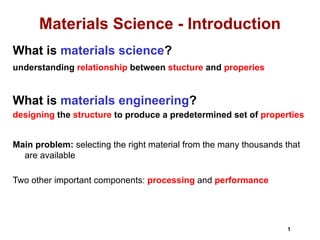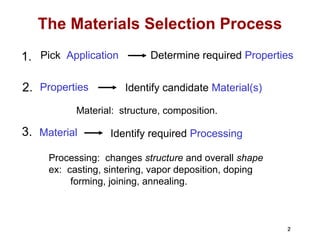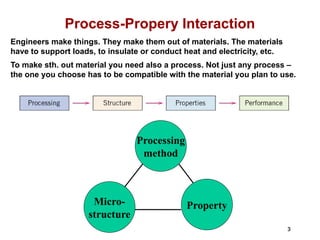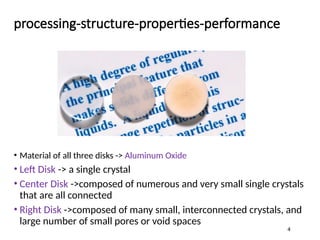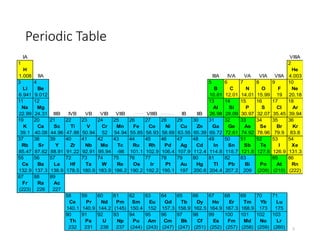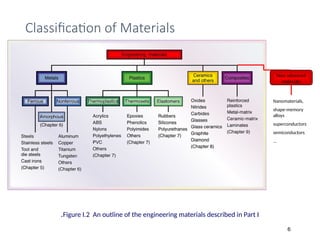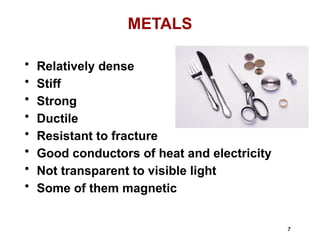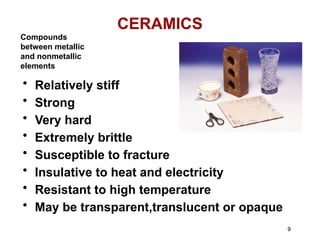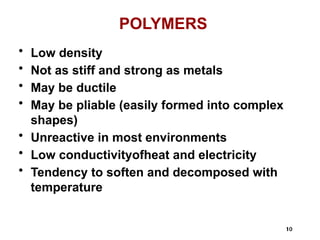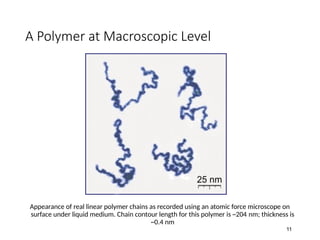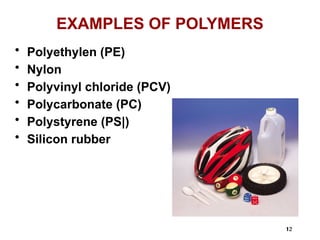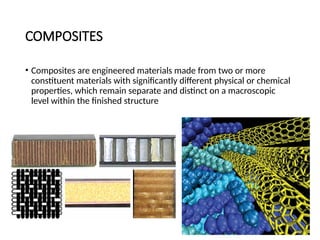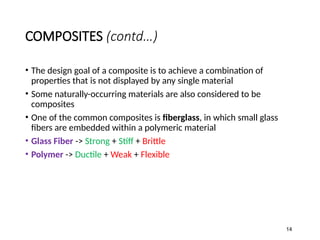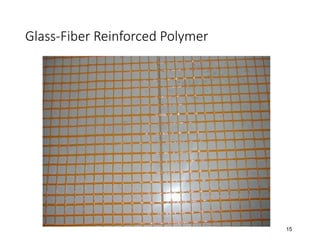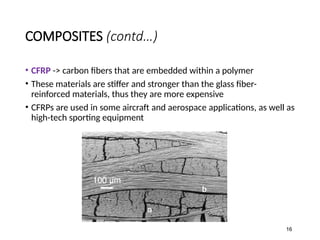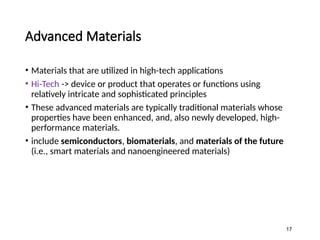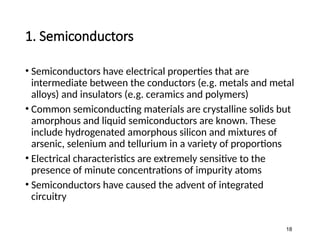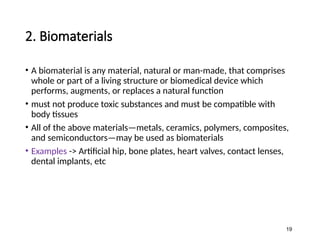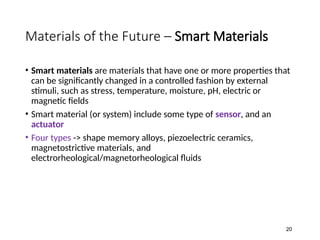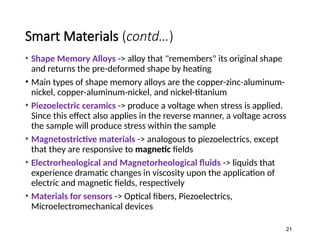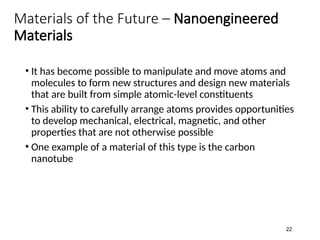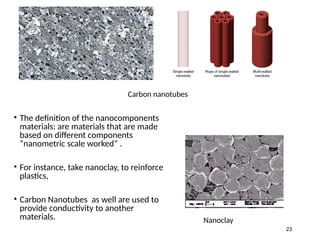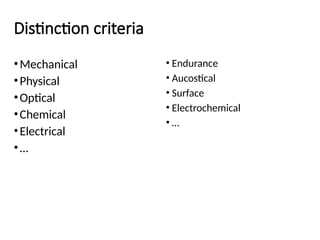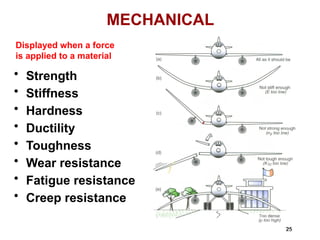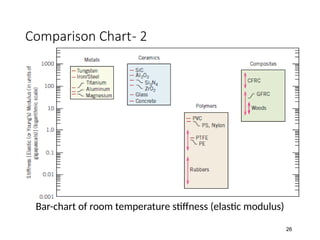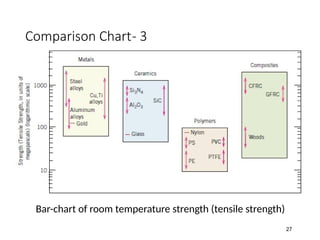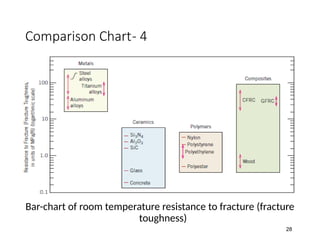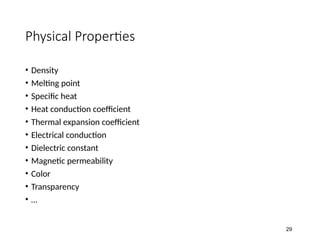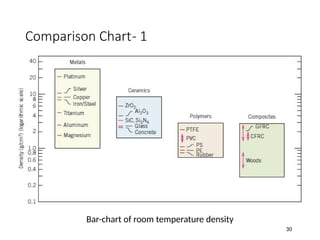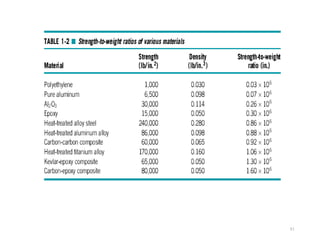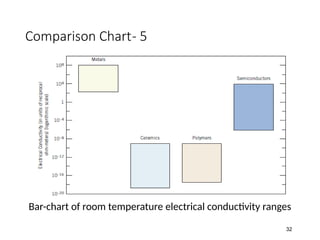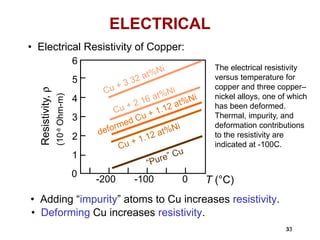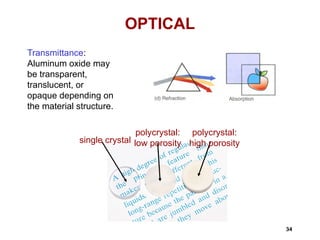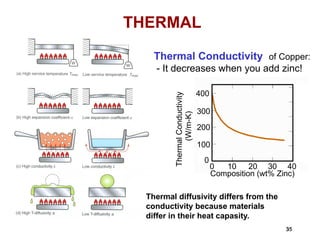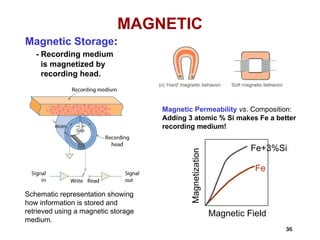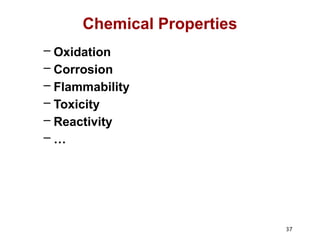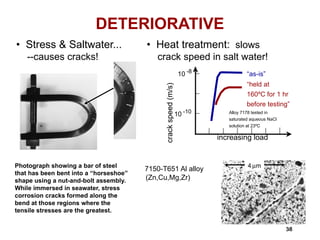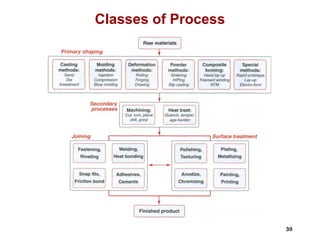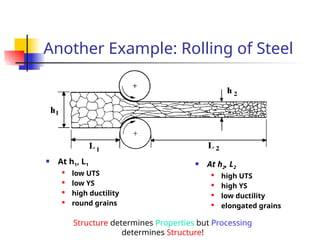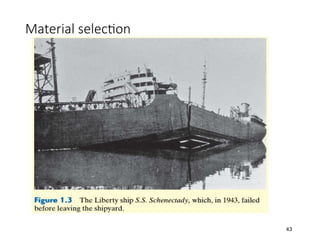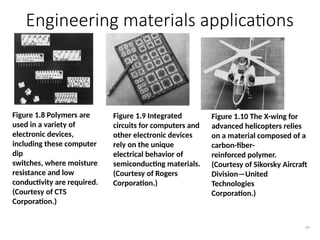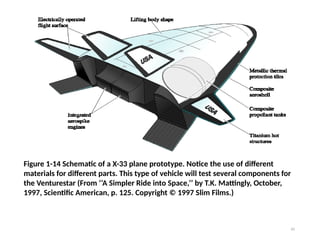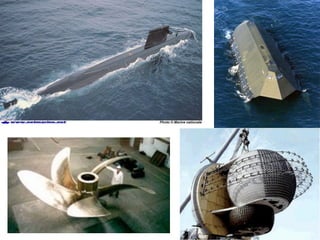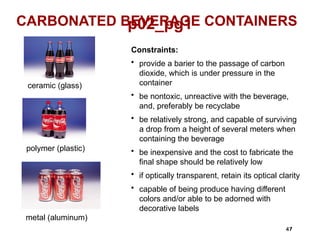material selection for marin products 1 .pptx
- 1. 1 1 Materials Science - Introduction What is materials science? understanding relationship between stucture and properies What is materials engineering? designing the structure to produce a predetermined set of properties Main problem: selecting the right material from the many thousands that are available Two other important components: processing and performance
- 2. 2 2 1. Pick Application Determine required Properties 2. Properties Identify candidate Material(s) 3. Material Identify required Processing Processing: changes structure and overall shape ex: casting, sintering, vapor deposition, doping forming, joining, annealing. Material: structure, composition. The Materials Selection Process
- 3. 3 3 Process-Propery Interaction Processing method Micro- structure Property Engineers make things. They make them out of materials. The materials have to support loads, to insulate or conduct heat and electricity, etc. To make sth. out material you need also a process. Not just any process ŌĆō the one you choose has to be compatible with the material you plan to use.
- 4. processing-structure-properties-performance ŌĆó Material of all three disks -> Aluminum Oxide ŌĆó Left Disk -> a single crystal ŌĆó Center Disk ->composed of numerous and very small single crystals that are all connected ŌĆó Right Disk ->composed of many small, interconnected crystals, and large number of small pores or void spaces 4
- 5. 5 Periodic Table IA VIIIA 1 2 H He 1.008 IIA IIIA IVA VA VIA VIIA 4.003 3 4 5 6 7 8 9 10 Li Be B C N O F Ne 6.941 9.012 10.81 12.01 14.01 15.99 19 20.18 11 12 13 14 15 16 17 18 Na Mg Al Si P S Cl Ar 22.99 24.31 IIIB IVB VB VIB VIIB VIIIB IB IIB 26.98 28.09 30.97 32.07 35.45 39.94 19 20 21 22 23 24 25 26 27 28 29 30 31 32 33 34 35 36 K Ca Sc Ti V Cr Mn Fe Co Ni Cu Zn Ga Ge As Se Br Kr 39.1 40.08 44.96 47.88 50.94 52 54.94 55.85 58.93 58.69 63.55 65.39 69.72 72.61 74.92 78.96 79.9 83.8 37 38 39 40 41 42 43 44 45 46 47 48 49 50 51 52 53 54 Rb Sr Y Zr Nb Mo Tc Ru Rh Pd Ag Cd In Sn Sb Te I Xe 85.47 87.62 88.91 91.22 92.91 95.94 -98 101.1 102.9 106.4 107.9 112.4 114.8 118.7 121.8 127.6 126.9 131.3 55 56 57 72 73 74 75 76 77 78 79 80 81 82 83 85 86 Cs Ba La Hf Ta W Re Os Ir Pt Au Hg Tl Pb Bi Po At Rn 132.9 137.3 138.9 178.5 180.9 183.9 186.2 190.2 192.2 195.1 197 200.6 204.4 207.2 209 (209) (210) (222) 87 88 89 Fr Ra Ac (223) 226 227 58 59 60 61 62 63 64 65 66 67 68 69 70 71 Ce Pr Nd Pm Sm Eu Gd Tb Dy Ho Er Tm Yb Lu 140.1 140.9 144.2 (145) 150.4 152 157.3 158.9 162.5 164.9 167.3 168.9 173 175 90 91 92 93 94 95 96 97 98 99 100 101 102 103 Th Pa U Np Pu Am Cm Bk Cf Es Fm Md No Lr 232 231 238 237 (244) (243) (247) (247) (251) (252) (257) (258) (259) (260)
- 6. Classification of Materials Figure I.2 An outline of the engineering materials described in Part I . New advanced materials Nanomaterials, shape-memory alloys superconductors semiconductors ŌĆ” 6
- 7. 7 7 METALS ŌĆó Relatively dense ŌĆó Stiff ŌĆó Strong ŌĆó Ductile ŌĆó Resistant to fracture ŌĆó Good conductors of heat and electricity ŌĆó Not transparent to visible light ŌĆó Some of them magnetic
- 8. 9 9 CERAMICS ŌĆó Relatively stiff ŌĆó Strong ŌĆó Very hard ŌĆó Extremely brittle ŌĆó Susceptible to fracture ŌĆó Insulative to heat and electricity ŌĆó Resistant to high temperature ŌĆó May be transparent,translucent or opaque Compounds between metallic and nonmetallic elements
- 9. 10 10 POLYMERS ŌĆó Low density ŌĆó Not as stiff and strong as metals ŌĆó May be ductile ŌĆó May be pliable (easily formed into complex shapes) ŌĆó Unreactive in most environments ŌĆó Low conductivityofheat and electricity ŌĆó Tendency to soften and decomposed with temperature
- 10. A Polymer at Macroscopic Level Appearance of real linear polymer chains as recorded using an atomic force microscope on surface under liquid medium. Chain contour length for this polymer is ~204 nm; thickness is ~0.4 nm 11
- 11. 12 12 EXAMPLES OF POLYMERS ŌĆó Polyethylen (PE) ŌĆó Nylon ŌĆó Polyvinyl chloride (PCV) ŌĆó Polycarbonate (PC) ŌĆó Polystyrene (PS|) ŌĆó Silicon rubber
- 12. COMPOSITES ŌĆó Composites are engineered materials made from two or more constituent materials with significantly different physical or chemical properties, which remain separate and distinct on a macroscopic level within the finished structure
- 13. COMPOSITES (contdŌĆ”) ŌĆó The design goal of a composite is to achieve a combination of properties that is not displayed by any single material ŌĆó Some naturally-occurring materials are also considered to be composites ŌĆó One of the common composites is fiberglass, in which small glass fibers are embedded within a polymeric material ŌĆó Glass Fiber -> Strong + Stiff + Brittle ŌĆó Polymer -> Ductile + Weak + Flexible 14
- 15. COMPOSITES (contdŌĆ”) ŌĆó CFRP -> carbon fibers that are embedded within a polymer ŌĆó These materials are stiffer and stronger than the glass fiber- reinforced materials, thus they are more expensive ŌĆó CFRPs are used in some aircraft and aerospace applications, as well as high-tech sporting equipment 16
- 16. Advanced Materials ŌĆó Materials that are utilized in high-tech applications ŌĆó Hi-Tech -> device or product that operates or functions using relatively intricate and sophisticated principles ŌĆó These advanced materials are typically traditional materials whose properties have been enhanced, and, also newly developed, high- performance materials. ŌĆó include semiconductors, biomaterials, and materials of the future (i.e., smart materials and nanoengineered materials) 17
- 17. 1. Semiconductors ŌĆó Semiconductors have electrical properties that are intermediate between the conductors (e.g. metals and metal alloys) and insulators (e.g. ceramics and polymers) ŌĆó Common semiconducting materials are crystalline solids but amorphous and liquid semiconductors are known. These include hydrogenated amorphous silicon and mixtures of arsenic, selenium and tellurium in a variety of proportions ŌĆó Electrical characteristics are extremely sensitive to the presence of minute concentrations of impurity atoms ŌĆó Semiconductors have caused the advent of integrated circuitry 18
- 18. 2. Biomaterials ŌĆó A biomaterial is any material, natural or man-made, that comprises whole or part of a living structure or biomedical device which performs, augments, or replaces a natural function ŌĆó must not produce toxic substances and must be compatible with body tissues ŌĆó All of the above materialsŌĆömetals, ceramics, polymers, composites, and semiconductorsŌĆömay be used as biomaterials ŌĆó Examples -> Artificial hip, bone plates, heart valves, contact lenses, dental implants, etc 19
- 19. Materials of the Future ŌĆō Smart Materials ŌĆó Smart materials are materials that have one or more properties that can be significantly changed in a controlled fashion by external stimuli, such as stress, temperature, moisture, pH, electric or magnetic fields ŌĆó Smart material (or system) include some type of sensor, and an actuator ŌĆó Four types -> shape memory alloys, piezoelectric ceramics, magnetostrictive materials, and electrorheological/magnetorheological fluids 20
- 20. Smart Materials (contdŌĆ”) ŌĆó Shape Memory Alloys -> alloy that "remembers" its original shape and returns the pre-deformed shape by heating ŌĆó Main types of shape memory alloys are the copper-zinc-aluminum- nickel, copper-aluminum-nickel, and nickel-titanium ŌĆó Piezoelectric ceramics -> produce a voltage when stress is applied. Since this effect also applies in the reverse manner, a voltage across the sample will produce stress within the sample ŌĆó Magnetostrictive materials -> analogous to piezoelectrics, except that they are responsive to magnetic fields ŌĆó Electrorheological and Magnetorheological fluids -> liquids that experience dramatic changes in viscosity upon the application of electric and magnetic fields, respectively ŌĆó Materials for sensors -> Optical fibers, Piezoelectrics, Microelectromechanical devices 21
- 21. Materials of the Future ŌĆō Nanoengineered Materials ŌĆó It has become possible to manipulate and move atoms and molecules to form new structures and design new materials that are built from simple atomic-level constituents ŌĆó This ability to carefully arrange atoms provides opportunities to develop mechanical, electrical, magnetic, and other properties that are not otherwise possible ŌĆó One example of a material of this type is the carbon nanotube 22
- 22. ŌĆó The definition of the nanocomponents materials: are materials that are made based on different components ŌĆ£nanometric scale workedŌĆØ . ŌĆó For instance, take nanoclay, to reinforce plastics, ŌĆó Carbon Nanotubes as well are used to provide conductivity to another materials. Carbon nanotubes Nanoclay 23
- 23. Distinction criteria ŌĆóMechanical ŌĆóPhysical ŌĆóOptical ŌĆóChemical ŌĆóElectrical ŌĆóŌĆ” ŌĆó Endurance ŌĆó Aucostical ŌĆó Surface ŌĆó Electrochemical ŌĆó ŌĆ”
- 24. 25 25 MECHANICAL ŌĆó Strength ŌĆó Stiffness ŌĆó Hardness ŌĆó Ductility ŌĆó Toughness ŌĆó Wear resistance ŌĆó Fatigue resistance ŌĆó Creep resistance Displayed when a force is applied to a material
- 25. Comparison Chart- 2 Bar-chart of room temperature stiffness (elastic modulus) 26
- 26. Comparison Chart- 3 Bar-chart of room temperature strength (tensile strength) 27
- 27. Comparison Chart- 4 Bar-chart of room temperature resistance to fracture (fracture toughness) 28
- 28. Physical Properties ŌĆó Density ŌĆó Melting point ŌĆó Specific heat ŌĆó Heat conduction coefficient ŌĆó Thermal expansion coefficient ŌĆó Electrical conduction ŌĆó Dielectric constant ŌĆó Magnetic permeability ŌĆó Color ŌĆó Transparency ŌĆó ŌĆ” 29
- 29. Comparison Chart- 1 Bar-chart of room temperature density 30
- 30. 31
- 31. Comparison Chart- 5 Bar-chart of room temperature electrical conductivity ranges 32
- 32. 33 33 ELECTRICAL ŌĆó Electrical Resistivity of Copper: ŌĆó Adding ŌĆ£impurityŌĆØ atoms to Cu increases resistivity. ŌĆó Deforming Cu increases resistivity. The electrical resistivity versus temperature for copper and three copperŌĆō nickel alloys, one of which has been deformed. Thermal, impurity, and deformation contributions to the resistivity are indicated at -100C. T (┬░C) -200 -100 0 Cu + 3.32 at%Ni Cu + 2.16 at%Ni deformed Cu + 1.12 at%Ni 1 2 3 4 5 6 Resistivity, r (10 -8 Ohm-m) 0 Cu + 1.12 at%Ni ŌĆ£PureŌĆØ Cu
- 33. 34 34 Transmittance: Aluminum oxide may be transparent, translucent, or opaque depending on the material structure. single crystal polycrystal: low porosity polycrystal: high porosity OPTICAL
- 34. 35 35 THERMAL Thermal Conductivity of Copper: - It decreases when you add zinc! Composition (wt% Zinc) Thermal Conductivity (W/m-K) 400 300 200 100 0 0 10 20 30 40 Thermal diffusivity differs from the conductivity because materials differ in their heat capasity.
- 35. 36 36 MAGNETIC Magnetic Permeability vs. Composition: Adding 3 atomic % Si makes Fe a better recording medium! Schematic representation showing how information is stored and retrieved using a magnetic storage medium. Magnetic Storage: - Recording medium is magnetized by recording head. Magnetic Field Magnetization Fe+3%Si Fe
- 36. Chemical Properties 37 ŌĆō Oxidation ŌĆō Corrosion ŌĆō Flammability ŌĆō Toxicity ŌĆō Reactivity ŌĆō ŌĆ”
- 37. 38 38 DETERIORATIVE ŌĆó Stress & Saltwater... --causes cracks! Photograph showing a bar of steel that has been bent into a ŌĆśŌĆśhorseshoeŌĆÖŌĆÖ shape using a nut-and-bolt assembly. While immersed in seawater, stress corrosion cracks formed along the bend at those regions where the tensile stresses are the greatest. 4 mm 7150-T651 Al alloy (Zn,Cu,Mg,Zr) ŌĆó Heat treatment: slows crack speed in salt water! ŌĆ£held at 160┬║C for 1 hr before testingŌĆØ increasing load crack speed (m/s) ŌĆ£as-isŌĆØ 10 -10 10 -8 Alloy 7178 tested in saturated aqueous NaCl solution at 23┬║C
- 39. Another Example: Rolling of Steel ’ü« At h1, L1 ’ü« low UTS ’ü« low YS ’ü« high ductility ’ü« round grains ’ü« At h2, L2 ’ü« high UTS ’ü« high YS ’ü« low ductility ’ü« elongated grains Structure determines Properties but Processing determines Structure!
- 41. 44 Figure 1.8 Polymers are used in a variety of electronic devices, including these computer dip switches, where moisture resistance and low conductivity are required. (Courtesy of CTS Corporation.) Figure 1.9 Integrated circuits for computers and other electronic devices rely on the unique electrical behavior of semiconducting materials. (Courtesy of Rogers Corporation.) Figure 1.10 The X-wing for advanced helicopters relies on a material composed of a carbon-fiber- reinforced polymer. (Courtesy of Sikorsky Aircraft DivisionŌĆöUnited Technologies Corporation.) Engineering materials applications
- 42. 45 Figure 1-14 Schematic of a X-33 plane prototype. Notice the use of different materials for different parts. This type of vehicle will test several components for the Venturestar (From ŌĆśŌĆśA Simpler Ride into Space,ŌĆÖŌĆÖ by T.K. Mattingly, October, 1997, Scientific American, p. 125. Copyright ┬® 1997 Slim Films.)
- 44. 47 47 p02_pg1 CARBONATED BEVERAGE CONTAINERS ceramic (glass) polymer (plastic) metal (aluminum) Constraints: ŌĆó provide a barier to the passage of carbon dioxide, which is under pressure in the container ŌĆó be nontoxic, unreactive with the beverage, and, preferably be recyclabe ŌĆó be relatively strong, and capable of surviving a drop from a height of several meters when containing the beverage ŌĆó be inexpensive and the cost to fabricate the final shape should be relatively low ŌĆó if optically transparent, retain its optical clarity ŌĆó capable of being produce having different colors and/or able to be adorned with decorative labels
Editor's Notes
- #4: a photograph showing three thin disk specimens placed over some printed matter. It is obvious that the optical properties (i.e., the light transmittance) of each of the three materials are different; the one on the left is transparent (i.e., virtually all of the reflected light passes through it), whereas the disks in the center and on the right are, respectively, translucent (allowing light to pass through diffusely) and opaque. that is, it is highly perfectŌĆöwhich gives rise to its transparency ŌĆ” the boundaries between these small crystals scatter a portion of the light reflected from the printed page, which makes this material optically translucent These pores also effectively scatter the reflected light and render this material opaque The structures of these three specimens are different in terms of crystal boundaries and pores, which affect the optical transmittance properties. Furthermore, each material was produced using a different processing technique. And, of course, if optical transmittance is an important parameter relative to the ultimate in-service application, the performance of each material will be different.
- #11: Y. Roiter and S. Minko, AFM Single Molecule Experiments at the Solid-Liquid Interface: In Situ Conformation of Adsorbed Flexible Polyelectrolyte Chains, Journal of the American Chemical Society, vol. 127, iss. 45, pp. 15688-15689 (2005).
- #13: The constituent materials come from the categories discussed aboveŌĆöviz., metals, ceramics, and polymers LEFT -> Glass/carbon/aramid fibres with thermoset/thermoplastic resins RIGHT -> single-walled nanotubes (yellow) bundle together when used as the reinforcing element of a composite material. The nanotubes are depicted at the interface with the polymer polyethylene (individual polymer molecules are shown in different shades of blue).
- #14: ŌĆ” and also to incorporate the best characteristics of each of the component materials. ŌĆ” ŌĆöe.g., wood and bone. However, most of those we consider in our discussions are synthetic (or man-made) composites ŌĆ” normally an epoxy or polyester. Thus, the resulting fiberglass is relatively stiff, strong, flexible, and ductile. In addition, it has a low density
- #16: Another of these technologically important materials is the ŌĆ£carbon fiber reinforced polymer ŌĆ” . e.g., bicycles, golf clubs, tennis rackets, and skis/snowboards
- #17: 2. Examples include electronic equipment (camcorders, CD/DVD players, etc.), computers, fiber-optic systems, spacecraft, aircraft, and military rocketry 3. ŌĆ” they may be of all material types (e.g., metals, ceramics, polymers), and are normally expensive
- #18: 1. A semiconductor is a material that has an electrical conductivity due to flowing electrons (as opposed to ionic conductivity) 3. ŌĆ” for which the concentrations may be controlled over very small spatial regions. Amorphous -> without real or apparent crystalline form 4. ŌĆ” that has totally revolutionized the electronics and computer industries (not to mention our lives) over the past three decades.
- #19: Biomaterials are employed in components implanted into the human body for replacement of diseased or damaged body parts ŌĆ” i.e., must not cause adverse biological reactions
- #20: that will have a significant influence on many of our technologies. ŌĆ” Term ŌĆ£smartŌĆØ implies that these materials are able to sense changes in their environments and then respond to these changes in predetermined mannersŌĆö traits that are also found in living organisms Sensor (that detects an input signal); Actuator (that performs a responsive and adaptive function)ŌĆ” ŌĆ”. Actuators may be called upon to change shape, position, natural frequency, or mechanical characteristics in response to changes in temperature, electric fields, and/or magnetic fields
- #21: metals that, after having been deformed, revert back to their original shapes when temperature is changed ŌĆ” The large deformation results due to martensitic phase change (pseudoelasticity) . Piezoelectric ceramics expand and contract in response to an applied electric field (or voltage); conversely, they also generate an electric field when their dimensions are altered
- #22: with the advent of scanning probe microscopes, which permit observation of individual atoms and molecules ŌĆ” the ŌĆ£nanoŌĆØ prefix denotes that the dimensions of these structural entities are on the order of a nanometer (10e-9 m) m)ŌĆöas a rule, less than 100 nanometers (equivalent to approximately 500 atom diameters)
- #30: GFRC -> Glass Fiber Reinforced Concrete CFRC -> Carbon Fiber Reinforced Composite PTFE -> poly tetra fluoro ethylene PS -> Poly styrene PE -> Poly ethylene
